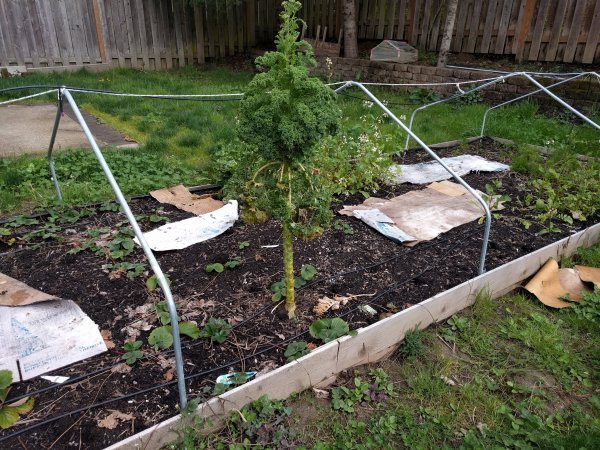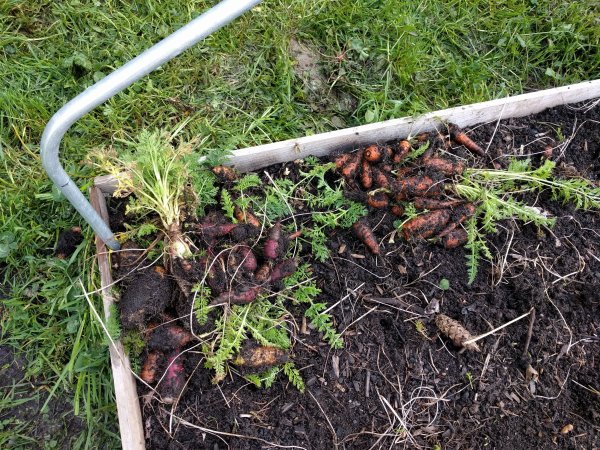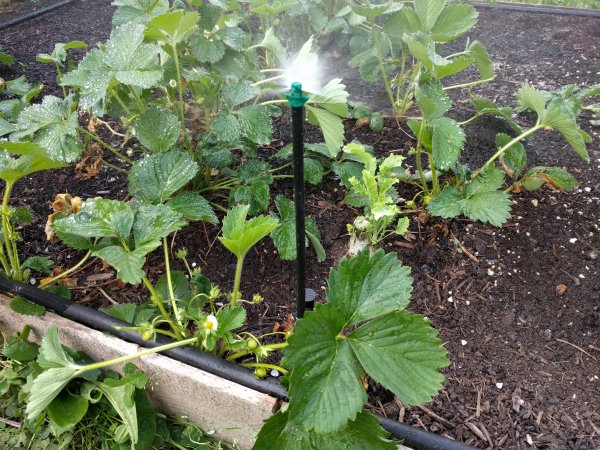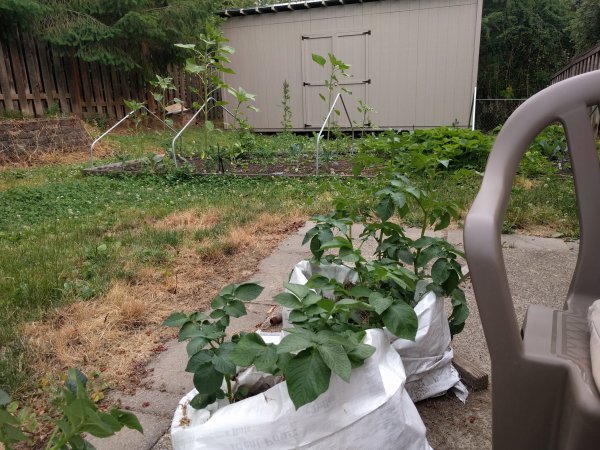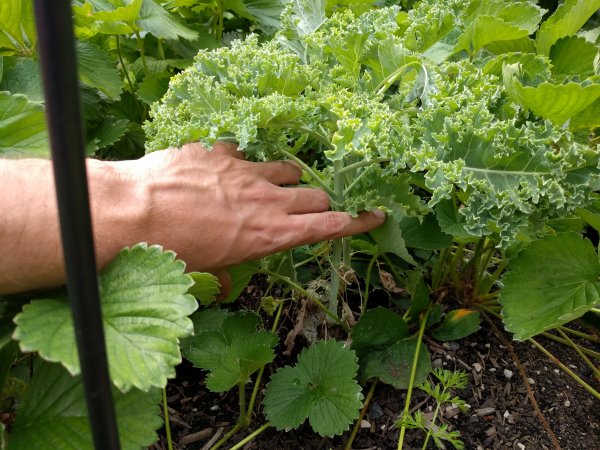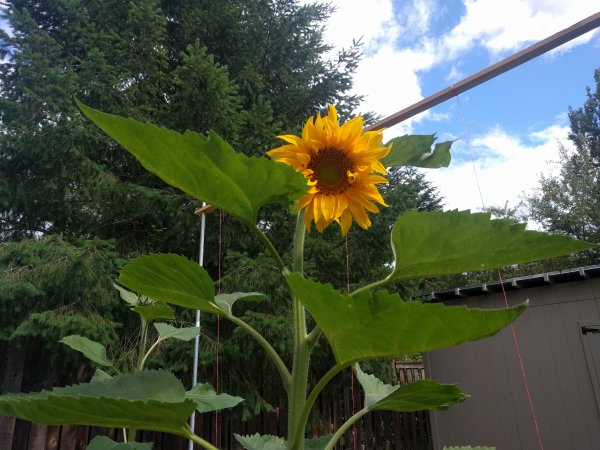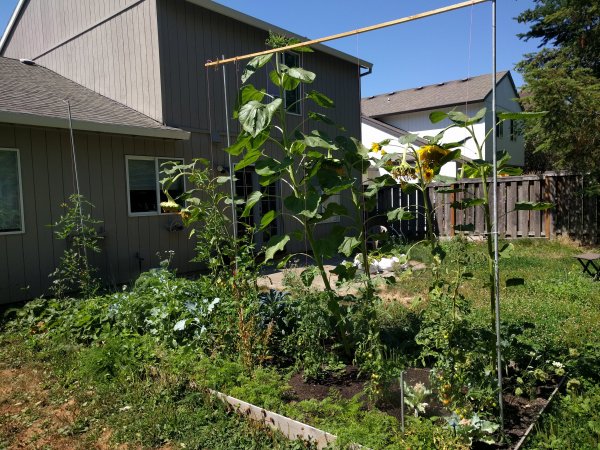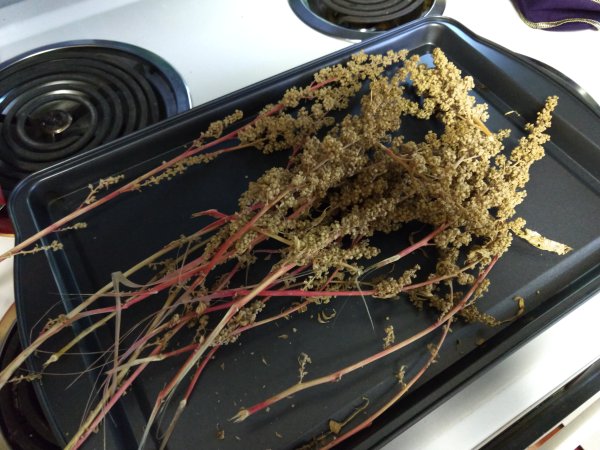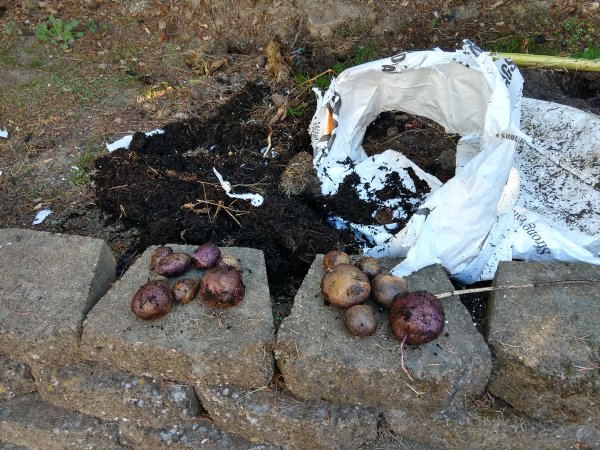Table of Contents
In 2017 I built my raised bed and put a lot of vegetables in. 2018 was the first full year with the garden and it really showed.
Overwintered Plants
I took a very passive approach to my garden in the winter. While it was mostly driven by my lazyness and lack of knowlege on winter crops, I like to pretend it was a well thought out experiment on what crops can survive in Oregon's relatively mild winter.
2018-03-17 Kale is notoriously cold-hearty, and this plant made it to spring. However, the leaves that survived the snow noticably drooped, and only the new growth looked healthy.
Also seen here is sparse strawberry plants. They are all clones of a single plant I purchsed at the supermarket late in the spring; strawberries are perhaps the most self-sufficent plants in my garden. On the right side of the picture are some carrot tops. As long as nothing is eating the carrots, they store very well in the ground. I also attempted to throw down some cardboard as mulch, but in an active gardent the cardboard is not a good idea; it composts too slowly.
2018-03-17 This year I attempted to jump start the garden with a poly low tunnel. I made the decision to cut down the lone kale plant in order to allow this plastic sheeting over the garden. I know professional farmers will do similar setups, however I'm not convinced the low tunnel helped very much. Additionally, with the tunnel I had a serious slug problem. While slugs are always a threat I suspect the lack of avian preditors exasterbated the problem.
2018-03-31 Periodically I would pull back the low tunnel and hunt for any weeds that are germinating. Being a firm believer in pyrotechnics, I used this cane style flame weeded to burn the weedlings. It was effective although in general weeding is time consuming. In this picture I still hadn't planted the new plants yet.
2018-03-31 The remaining carrots. These were planted approximately a year ago, and still tasted great.
Seeds and Seedlings
I tried to get started earlier this year and grew some plants from seed. I was mostly successful, but the biggest benifit was the learings of my first full year with a garden.
2018-04-08 I attempted potatoes in polyurethane demolition bags. In 2016 I had a planter for my potatoes and it was very easy to harvest. Digging for the 2017 potatoes was fine, but I was more concerned with disterbing the other plants in my raised bed, so 2018 switched back to dedicated potato grow space.
2018-04-09 Over the last few years I started researching this new hobby, which includes reading sead catalogues. Which leads to purchasing seeds. Here is my sprouting area in my kitchen.
I really struggled with this planter. I was never confident when to water, when to cover/uncover, or the temperature. The sunflowers in the foreground look great, but they have some sibblings still in the try who aren't doing as well.
2018-04-18 Here is the sunflowers in the soil. I attribute the damage to the slugs I mentioned before. The damaged plants still grew, but this strong looking plant persisted through the rest of the season as the biggest and first plant.
2018-05-01 Two weeks later I redid my irrigation system to use spray emiters instead of drip lines. My modivation for the change: 1) allow easy access to the soil for raking and planting 2) more even watering 3) cool plants during the heat of the summer. It delivered on these items, and perhaps most importantly the easy access allowed me to leave this irrigation installed into 2019.
2018-05-01 A closeup of my irrigation and my overwintered strawberries.
Summer
Summer provides rapid growth and the garden starts to take shape.
2018-06-20 The potatoes look healthy and the sunflowers have started to dominate the garden.
2018-06-27 At the end of June I put up EMT and strings for the tomato plants to climb.
2018-06-27 An experiment this year was not pulling the overwintered kale plant, but cutting it back. This picture shows the regrowth. Ultimately, new plants grew faster than this plant. I suspect if I had left the plant untouched, it would have been the most productive, however that would have prevented me from adding the tarp to warm the bed.
2018-07-10 The first sunflower blossom. I planted a mix of sunflowers but I suspect this is a mammoth variety.
2018-07-31 By the end of June my tomatoes are starting to ripen. These are sungold, which is one of my favourite cultivars.
2018-07-31 By the end of June my tomatoes are starting to ripen. These are sungold, which is one of my favourite cultivars.
2018-08-10 The garden has a lot of shape to it now! In the front is a single row of carrots. Tomatoes are climbng up pink strings with one lone tomato plant also next to the house. Between the two tomato groups is kale. Sunflowers are leaning dangerously behind the tomatoes, and strawberry plants provide ground cover on the left side.
A limited harvest
I traveled a lot in the fall for work, and the garden was ignored quite a bit. I
2018-09-18 I planted a packet of quiona seeds, and they grew. This is my harvest from the two plants that produced. After collecting them, I let them dry (a few months thanks to my lack of ambition) and rolled the plants in my hand to separate the seeds. This manual processing is too labor intensive even for an expensive grain like quoina, and my cooking ability doesn't help either. I added them to a stew; it added calories but using quoina provided little unique benifit.
2018-09-22 The garden at the end of the summer. The sunflowers are leaning dangerously and I'm constantly debating what is ripe or not.
2018-10-20 I harvested the potatoes one bag at a time. I had decent yields, however I was watering by hand over the year and I believe the potatoes could have used more; particularly because the bags drained well and I used grass clippings to hill up the plants. The biggest issue in this picture is the degrading bag. The plastic cannot survive a summer in the sun and flaked apart when inverting to dump out the potatoes.
2018-10-20 Two of the four bags of potatoes looked like this. I'm unsure what the problem is, but my best guess is a lack of water. The leaves turned brown but never looked dieseased, and given my irregular watering schedule lack of water fits the problem statement.
Learnings from 2018
I'm really proud of my gardens progress and I gained a lot of valuable experience. Some key takeaways and learnings from this season:
- Strawberries in the spring can spread fast
- June bearing strawberries are a mistake in the context of my garden. The plants remained all summer but I only had one harvest (in May)
- Demolition bags degrade in the sun and cannot be used as potato planters
- Sunflowers are fun to grow. However, they are massive shading the area below them, and at the end of the season they start to lean over their own weight potentially interfearing with other plants. They shouldn't go in the prime real estate of the raised bed, but I would like to try planting them in other locations
- Growing seedlings is a waste of time for me. My context needs tens of plants with lots of variation. If the seed packet costs the same as a seedling and I only need three seedlings, there is little financial incentive. Also, my work trips can pull me away from seedlings when they have little room for error
- The tomato system using EMT and twine is excellent. I learned this technique from growers in greenhouses, and I believe the use of EMT is the best way of replicating the hanging strings in a small outdoor garden.
- I used polypropylene string for the tomato hanging. Polypropylene degrades in sunlight, and by the end of the summer the strings would snap and I found it very difficult to recover that plant.
- In Oregon, April is reasonable to put plants in the ground. The cold hearty plants that overwintered still had an advantage over the new plants, so I probably can push planting almost to March with some luck in the weather.
